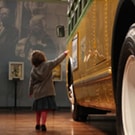Rocking Chair Used by Abraham Lincoln at Ford's Theater the Night of His Assassination, April 14, 1865
Add to SetSummary
President Abraham Lincoln was sitting in this rocking chair during a production of Our American Cousin at Ford's Theatre in Washington, D.C., when he was assassinated on April 14, 1865. Henry Ford purchased the chair in 1929 for the Museum, where it remains one of the most revered objects associated with the "man who saved the Union." …
President Abraham Lincoln was sitting in this rocking chair during a production of Our American Cousin at Ford's Theatre in Washington, D.C., when he was assassinated on April 14, 1865. Henry Ford purchased the chair in 1929 for the Museum, where it remains one of the most revered objects associated with the "man who saved the Union."
The Lincoln Assassination Chair History 29.1451.1
Originally purchased as part of a parlor suite, the rocking chair was intended for use in a reception room in Ford's Theatre, which opened in 1863. The parlor suite was purchased by Harry Clay Ford (no relation to Henry Ford) manager of the Theatre. However, the comfortable rocking chair began to be used by ushers during their "down" time and the fabric became soiled by their hair oil. This stain is still visible on the back. Sometime in 1864, Harry Ford had the chair moved to his apartment across the alley from the Theatre in a belated attempt to keep it clean.
Beginning with the Theatre's opening in 1863, President Lincoln became a frequent visitor. At some point, Mr. Ford began to supply the president and his party with comfortable seating furniture. Apparently, the president preferred this rocking chair, perhaps, due to his height. On the afternoon of April 14th, the chair was brought to the president's box along with a matching sofa and side chair. After the assassination, the Theatre and its contents was seized by the Federal government.
After its seizure, the chair remained in the private office of the Secretary of War, Edwin Stanton. In 1867, the chair was transferred to the Department of the Interior and then sent to the Smithsonian Institution and placed in storage. For all practical purposes, the chair vanished from the public for half a century. Documentation at the Smithsonian indicates that it was catalogued into the collection in 1902.
An unrelated Civil War event brought the red rocker back into the public eye. In the last year of the War, Jefferson Davis, President of the Confederacy, was captured and his personal belongings were seized by the government. In 1913, the Davis heirs challenged the validity of this action. Their contention was upheld by the United States Attorney General as there had been no legal proceedings to acquire title to Davis's possessions--they remained the property of the heirs. President Woodrow Wilson returned the items by executive order.
In 1927 Mrs. Blanche Chapman Ford, widow of Harry Clay Ford, the man who supplied the rocking chair for the president's box learned of the Davis case. As his widow and heir, she applied for return of her chair in November of that year. The precedent of the Davis disposition was recalled and by order of the War Department (where it had originally been accessioned as a deposit) the chair was ordered returned to its rightful owner, Blanche Ford. In the spring of 1929 the Curator of History at the Smithsonian delivered the rocker to her son.
Mrs. Ford sold the chair at auction through the Anderson Galleries in New York on December 17, 1929. The purchaser was Israel Sack, the dean of antique American furniture dealers, and an agent of Henry Ford. Sack had observed that Ford delighted in furniture that had association with American historical figures. Sack, in turn, offered the chair to Mr. Ford, who purchased it and carefully documented its arrival in Greenfield Village in early 1930. There, the chair resided in the Logan County, Illinois Court House where Lincoln practiced law as a circuit rider in the 1840s. Mr. Ford had moved the Court House to Greenfield Village in 1929--the chair became the centerpiece of his Lincoln collection. In 1979, as part of the institution's fiftieth anniversary, the chair moved from the Court House to the Museum, where it remains today.
By the early 1990s, conservators recognized that the fragile silk upholstery was degrading, even though the chair was always displayed in an exhibit case, requiring action. In preparation for conservation, eleven fabric samples were analyzed to determine the composition of both the fabric and the stains on the upholstery. The results aided conservators and curators in determining which stains should be preserved and which could be removed to minimize damage to the upholstery.
Microscopic analysis determined that calcium sulfate commonly known as plaster of Paris was present in many of the samples, including a large area on the base of the chair back and seat. This stain is consistent with documentation that suggests the chair was stored in a basement after the assassination and prior to its purchase by Mr. Ford.
A preliminary test for blood using the reagent Benzidine yielded positive results in two areas--the front of the seat and near the upper portion of the back. More extensive testing would be required to provide additional information regarding its origin. Given the chair's well-documented history and a lack of available samples of the President's blood and DNA, The Henry Ford has decided not to pursue further testing.
In 1996, following testing, museum conservators carefully cleaned the delicate silk fabric and removed some plaster stains using a tiny spatula. The upholstery was then covered with a thin polyester fabric attached with adhesive and tiny stitches in order to hold the fragile fragments of the fabric together. After treatment the newly conserved chair returned to exhibit in the Museum. In 2006, the chair became a key artifact in a major exhibit on American freedom titled "With Liberty and Justice for All," where it may be seen today.
For decades, visitors to The Henry Ford have sought out the so-called Lincoln Rocker. They are drawn to it not simply because of its role at the center of a tragedy, but as symbol of a beloved president. There is a unique sense of awe and reverence that the chair provides. As such, this rocking chair personifies the sacrifice made by Abraham Lincoln in fashioning a more perfect Union.
Artifact
Rocking chair
Date Made
1855-1865
Subject Date
14 April 1865
Place of Creation
Keywords
United States, District of Columbia, Washington
Rathbone, Henry Reed, 1837-1911

On Exhibit
at Henry Ford Museum in With Liberty & Justice for All
Object ID
29.1451.1
Credit
From the Collections of The Henry Ford.
Material
Damask
Silk (Textile)
Upholstery
Walnut (Wood)
Technique
Carving (Processes)
Upholstering
Color
Brown
Red
Dimensions
Height: 42 in
Width: 36.625 in
Length: 34.5 in





